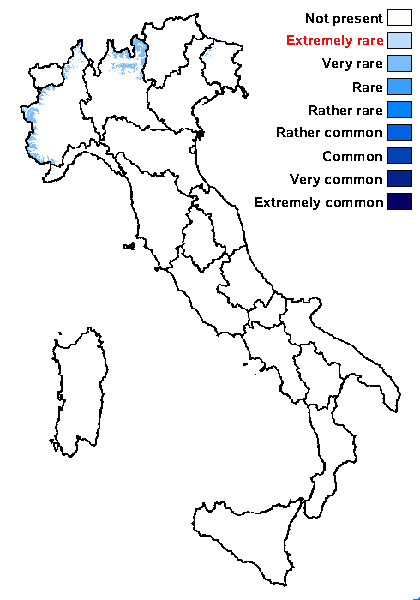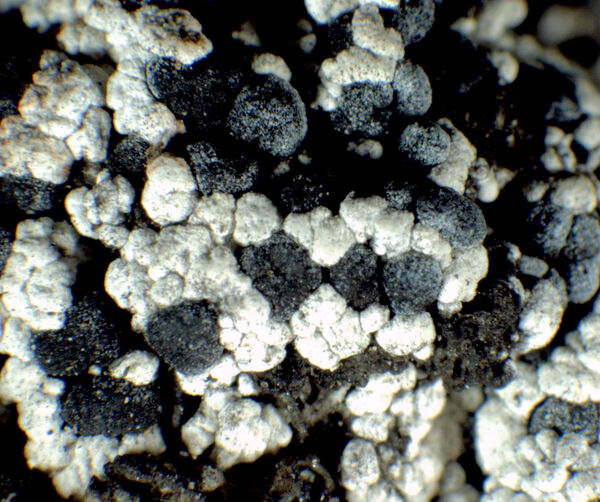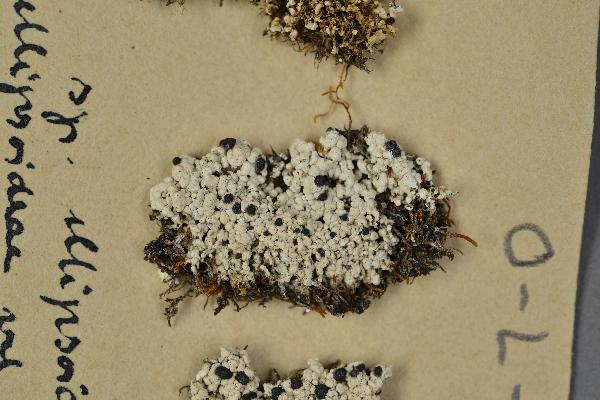Tetramelas papillatus (Sommerf.) Kalb
in Döbbeler & Rambold, Bibl. Lichenol, 88: 323, 2004. Basionym: Lecidea papillata Sommerf. - Suppl. Fl. Lapp.: 154, 1826.
Synonyms: Buellia papillata (Sommerf.) Tuck.; Buellia parasema var. papillata (Sommerf.) Th. Fr.
Distribution: N - Frl, Lomb, Piem (Isocrono & al. 2004), Lig (TSB 33479).
Description: Thallus crustose, episubstratic, rather thick, white to whitish grey, of convex to bullate, contiguous areoles, without a distinct prothallus. Medulla white, I-. Apothecia usually abundant, lecideine, black, 0.5-1.2(-1.5) mm across, broadly sessile, discrete to confluent, with a flat to strongly convex, rarely initially pruinose disc and a thin, soon excluded proper margin, when young often with an ephemeral thalline rim. Proper exciple dark-pigmented throughout; epithecium brown, N-; hymenium colourless, rarely inspersed with oil droplets, I+ blue; paraphyses branched in upper part, the apical cell swollen, with a brown cap; hypothecium dark brown. Asci 8-spored, clavate to cylindrical-clavate, the apical dome K/I+ dark blue with a pale, conical-pointed apical cushion (axial mass), the wall I-, but the thin outer gel I+ blue, Bacidia-type. Ascospores 1-septate, brown, ellipsoid, often slightly curved, 15-25 x 7-10 µm, Buellia-type, the wall uniformly thickened, finely warted. Photobiont chlorococcoid. Spot tests: thallus K+ pale yellow, C-, KC-, P- or P+ pale yellow, UV-. Chemistry: atranorin. Note: an arctic-alpine lichen found on terricolous bryophytes, mostly above treeline, reaching the nival belt in the Alps; it is related to T. insignis.
Growth form: Crustose
Substrata: soil, terricolous mosses, and plant debris
Photobiont: green algae other than Trentepohlia
Reproductive strategy: mainly sexual
Commonnes-rarity: (info)
Alpine belt: very rare
Subalpine belt: extremely rare
Oromediterranean belt: absent
Montane belt: absent
Submediterranean belt: absent
Padanian area: absent
Humid submediterranean belt: absent
Humid mediterranean belt: absent
Dry mediterranean belt: absent

Predictive model
Herbarium samples
Growth form: Crustose
Substrata: soil, terricolous mosses, and plant debris
Photobiont: green algae other than Trentepohlia
Reproductive strategy: mainly sexual
Commonnes-rarity: (info)
Alpine belt: very rare
Subalpine belt: extremely rare
Oromediterranean belt: absent
Montane belt: absent
Submediterranean belt: absent
Padanian area: absent
Humid submediterranean belt: absent
Humid mediterranean belt: absent
Dry mediterranean belt: absent

Predictive model
| Herbarium samples |
 INDEX FUNGORUM
INDEX FUNGORUM
 GBIF
GBIF
 DOLICHENS
DOLICHENS





